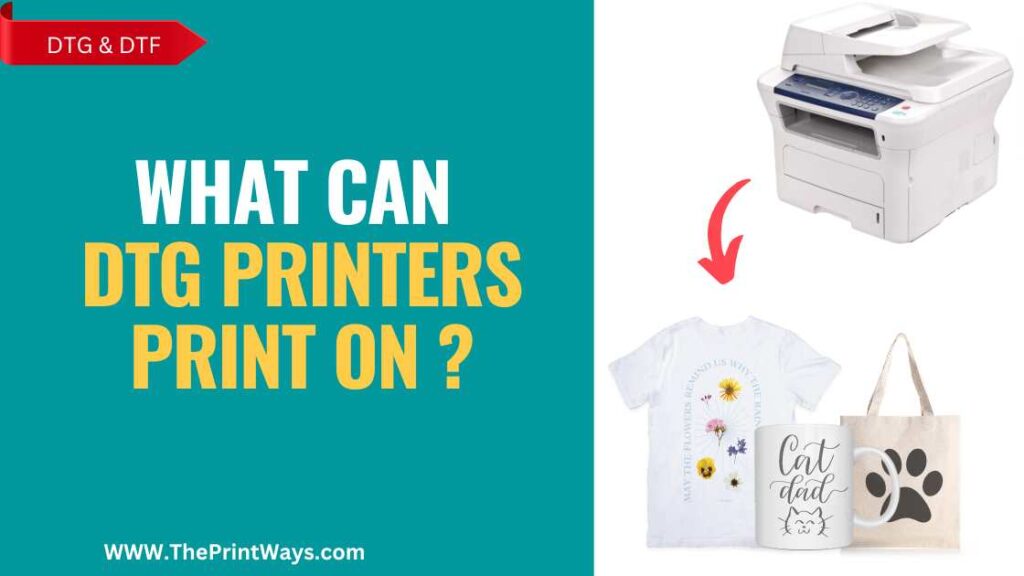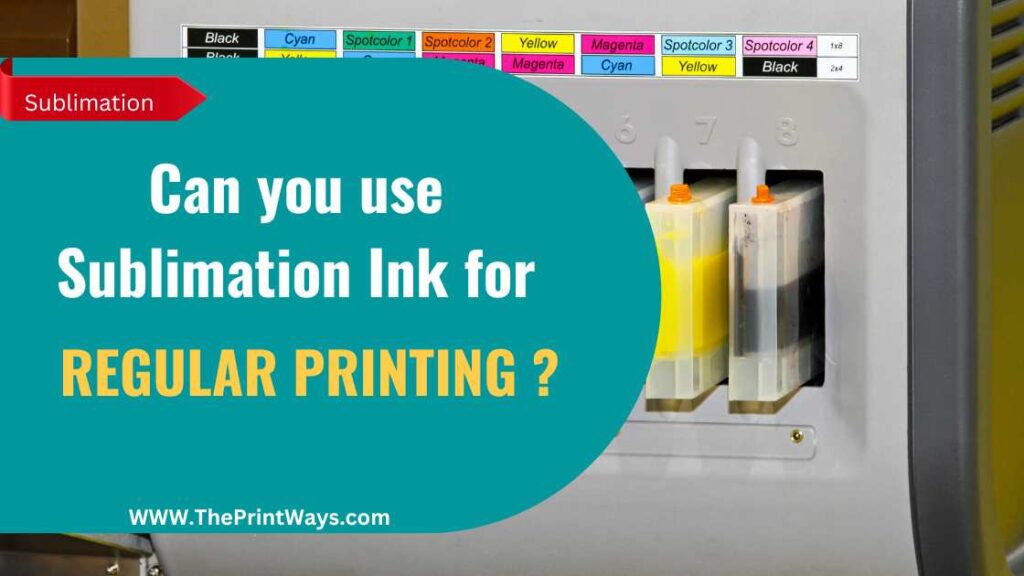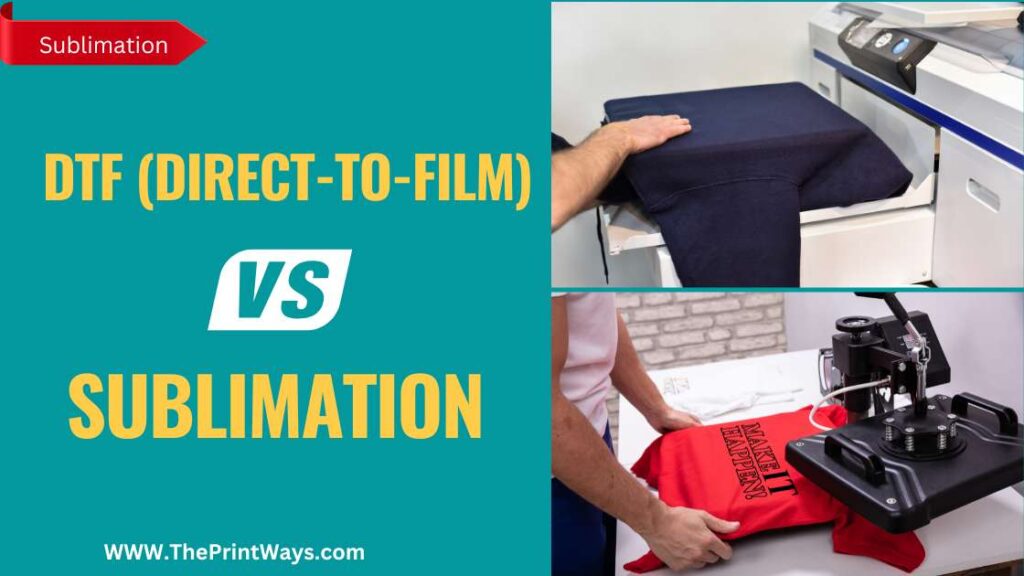DTG (Direct-to-Garment) is a very popular recent printing technology. But What can DTG printers print on? The most popular item for DTG printers is apparel such as t-shirts and other garments. These machines are able to quickly print graphics with high resolution onto cotton fabric without any pre-treatment or additional steps.
Not only do they allow for personalization and customization, but also provide customers with a unique way to express themselves through their clothing choices. As an added bonus, DTG prints are also highly durable — meaning your design won’t fade after multiple washes!
But apparel isn’t all that DTG printers can handle; they’re also great for customizing items like bags or accessories too. Whether you want to add a logo or slogan onto a bag or customize a pair of shoes with artwork, DTG offers plenty of opportunities for creativity here as well.
On top of being efficient and versatile, it’s also cost effective compared to traditional methods like screen printing since there’s no need for additional materials or processes.
What Is DTG Printing?
Direct-to-Garment (DTG) printing is an innovative method of garment decoration that prints directly onto fabric. It uses inkjet technology to print full-color designs, text, and photos on garments with great accuracy and clarity. DTG printing produces vibrant colors and high resolution images without the need for additional screens or transfers. This means it’s a fast and cost effective way to add custom graphics to apparel.
What can DTG printers Print On ?
DTG (Direct-to-Garment) printers can print on a variety of materials, including:
- Cotton and cotton blends: This is the most popular material for DTG printing. T-shirts, hoodies, and other apparel made from cotton or cotton blends can be easily printed on using DTG.
- Polyester and polyester blends: DTG can also print on materials made from polyester or polyester blends, such as performance wear or athletic jerseys.
- Canvas: Canvas materials, such as tote bags or canvas shoes, can also be printed on using DTG.
- Leather: Some DTG printers are capable of printing on leather materials, such as leather jackets or bags.
- Mugs: DTG can be used to print on ceramic mugs, creating personalized designs or logos.
- Phone cases: DTG can also be used to print on phone cases made from plastic or other materials.
- Hats and caps: DTG can print on hats and caps made from various materials, including cotton, polyester, and mesh.
Related: How Does DTG printing work ?
Best Types of Fabrics For DTG Printing
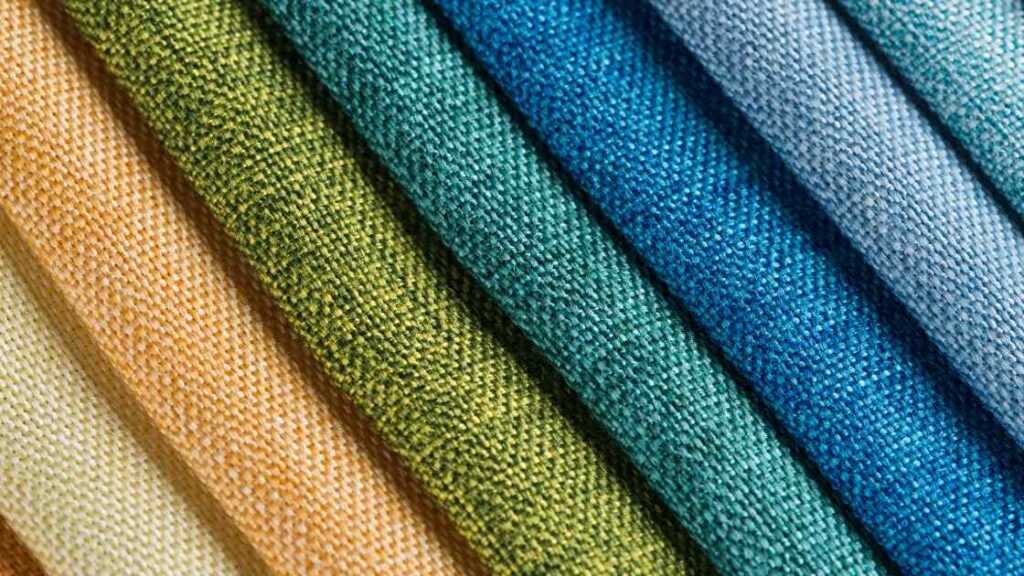
DTG printing is an efficient way to quickly produce custom apparel in a wide range of colors and designs. The key to successful DTG printing lies in selecting the right fabric for your design.
- Generally, natural fibers such as cotton and linen are ideal fabrics for this method of printing.
- Synthetic materials like polyester also work well but require special mixing techniques and additional pre-treatment steps prior to printing.
- Cotton blends, canvas, muslin, twill and bamboo are all great choices when it comes to fabric selection for DTG printed garments.
In addition to selecting quality materials that can be effectively prepared for print, consider how you want your garment to look and feel after being printed. Pay attention to texture, weight, breathability, drape and shrinkage properties of different types of fabrics so you end up with a finished product that looks beautiful.
Quality prepress makeup processes play a major role in producing vivid prints on any type of fabric – from light colored fabrics where white ink must be used as a base layer before applying color inks or dark colored cloths where no under base is necessary at all.
DTG Printing On Polyester
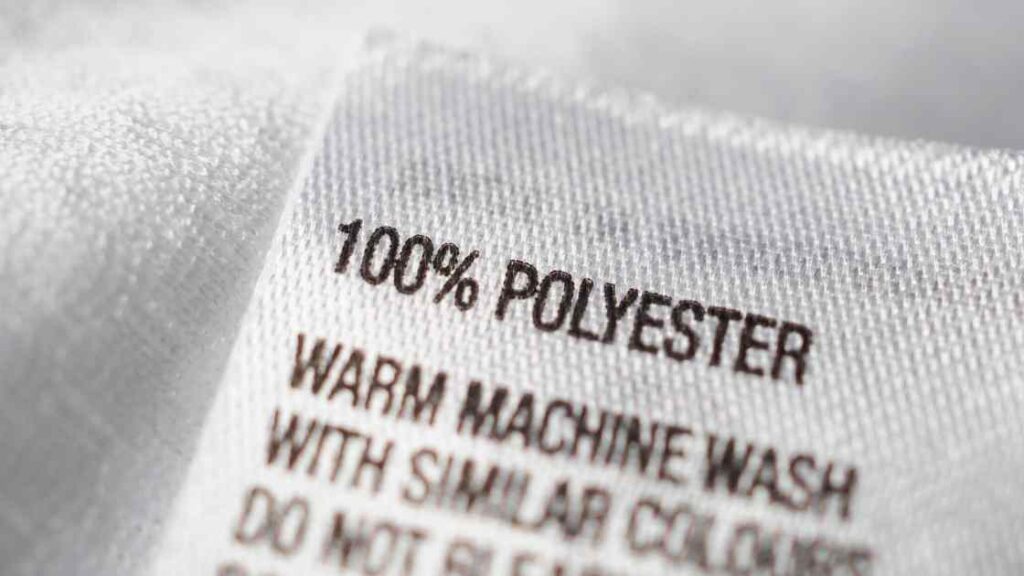
DTG printers can print on polyester fabrics, which is great for creating personalized apparel and accessories. Polyester is a lightweight, durable material that’s easy to care for and lasts longer than other fabric types. The colors produced by DTG printing are vibrant and long-lasting, meaning your custom designs will look fresh even after multiple washes.
Plus, the ink used in DTG printing isn’t as thick or heavy as traditional screen printing methods, so it won’t weigh down garments either! It’s also important to note that you’ll need special pretreatment solutions when printing on polyester with a DTG printer; otherwise, the prints may not adhere well to the fabric.
Also Read: DTG Vs Screen Printing: Ultimate Comparison
Direct To Garment Printing On Black Shirts
Direct to garment (DTG) printing can be used to print on black shirts. This method is a great choice for designs with vivid colors as it offers superior color reproduction and vibrancy compared to other methods of screen printing. It’s also good for small orders, since DTG prints don’t require setup fees like some other techniques.
The inks used in this process are water-based, which means they won’t fade over time and will stand the test of several washings without cracking or peeling off your shirt. Moreover, you can use white ink when printing on dark garments, allowing for more complex designs with multiple layers of colors and detailed artwork.
Best Pratices For A Vibrant DTG Print On Shirts
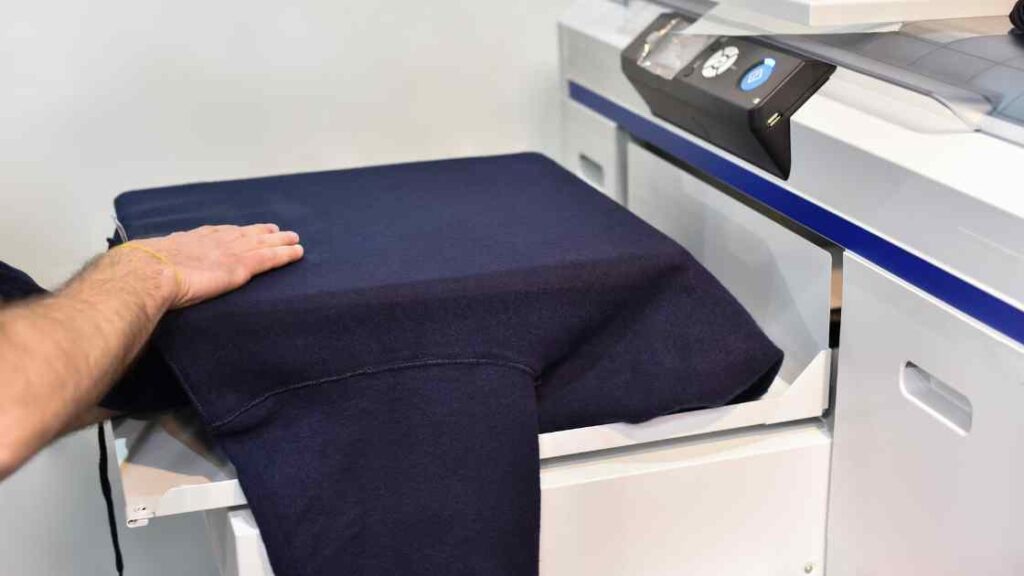
Now that you know how DTG works when it comes to dark garments, let’s look at some best practices for achieving a vibrant design.
- The first step in making sure your print pops off of the shirt is properly prepping the fabric.
- Start by washing and drying the shirt before beginning the printing process; this will remove any oils or dirt from the surface of the material so that your ink adheres correctly.
- The next step is using a pretreatment solution designed specifically for use with dark fabrics; this helps prevent fading over time by adding an extra layer of protection between the ink and fabric fibers.
- Once you have both of these steps completed, you’re almost ready to start printing!
- To ensure maximum vibrancy, make sure that you are using high-quality inks designed for DTG printers as well as setting up your printer correctly according to manufacturer instructions.
- Additionally, be sure to do multiple test prints before committing fully to a production run – this can help identify any potential issues before they become a problem.
With all of these tips in mind, you’ll be able to confidently produce stunning designs worthy of your customers’ admiration!
You May Like: Common Issues With DTG Printing.
Caring For DTG Shirts
Caring for a DTG shirt is important to ensure its longevity.
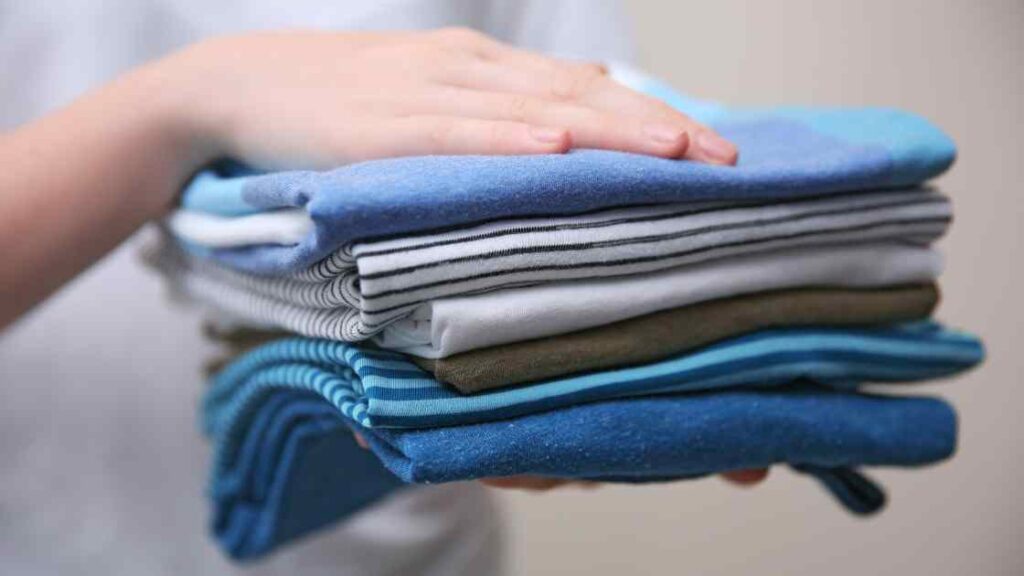
- Wash the shirt inside out, in cold water and with like colors. This will help reduce fading and prevent any color bleeding from other garments that were washed together.
- Air drying or tumble dry on low heat are both acceptable options when it comes to drying your garment. Avoid over-drying as this may lead to shrinkage of the material.
- Ironing should be done on an iron setting appropriate for the fabric type and preferably while still damp; using too hot a temperature can cause damage to some materials used for printing t-shirts via DTG.
- Regular washing is recommended but avoid bleach or harsh detergents which can damage the print quality and fade the colours over time.
- Careful consideration must also be taken when folding or storing shirts printed with a DTG printer, as creases can occur if not stored appropriately.
Taking these steps will keep your DTG printed shirts looking great for years to come!
Frequently Asked Questions
Q: What Is The Cost Of DTG Printing?
The cost of DTG printing can vary greatly depending on the complexity and size of the job. The type of garment, the number of colors in your design, as well as any special effects or treatments you may want to add all factors into the overall cost. It’s important to consider all costs when pricing a project – from supplies and equipment, to setup time and labor for production. Additionally, larger orders usually come with bulk discounts that help make DTG printing more affordable.
Q: How Long Does It Take To Print With A DTG Printer?
Printing with a Direct to Garment printer (DTG) can be an efficient process, but how long does it take? Depending on the complexity of the design and the size of the garment, DTG printing usually takes between one hour and two hours. In addition, some printers have built-in features that help speed up production time such as auto-adjustable platens.
Q: Are There Any Limits To The Colors I Can Print With DTG?
DTG printers are a great way to get high-quality prints in whatever design and color you desire. But it’s important to know what printing limitations come with the technology, such as how many colors you can print on a given fabric or product.
Q: Are there any limits to the colors you can print with DTG?
The answer is yes; however, most DTG printers today offer up to 16 million different color combinations. This means that whatever your desired outcome may be, whether two tones or full color images, you should have no issue achieving it using this type of printer. The only limit is really just imagination; so far as the number of possibilities goes, the sky’s the limit!
Q: Is The DTG Printer Suitable For Large Orders?
DTG (Direct to Garment) printers are increasingly popular for their ability to produce full-color prints quickly and cost-effectively. But is it suitable for large orders? Generally, the answer is yes; DTG printing can be a great option if you’re looking to print in bulk. It offers low setup costs and fast turnaround times, meaning you’ll have more of your finished product on hand sooner.
Q: Is The DTG Printer Compatible With Different Types Of Fabrics?
DTG printers are incredibly versatile and can be used to print on a variety of fabrics. They can be adapted to work with different materials, making them an excellent option for those looking to produce high-quality prints across a range of fabric types.
Conclusion
The DTG printer is a great option for customizing a wide variety of apparel and accessories. It’s cost-effective, fast, and can produce high-quality prints with almost any color combination you could imagine. Plus, it’s suitable for large orders too! Overall, DTG printers really are an ideal choice for anyone looking to customize their apparel in a cost effective way without compromising quality or versatility. So why not give them a try today? You won’t regret it!

